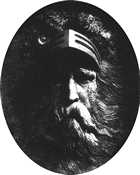![]()
Introduction
| He will have
it that Hamlet is a ghoststory, John Eglinton said for Mr. Best's
behoof. Like the fat boy in Pickwick he wants to make our flesh creep. List! List! O List! My flesh hears him: creeping, hears. If thou didst ever... What is a ghost? Stephen said with tingling energy. One who has faded into impalpability through death, through absence, through change of manners. Elizabethan London lay as far from Stratford as corrupt Paris lies from virgin Dublin. Who is the ghost from limbo partum, returning to the world that has forgotten him? Who is king Hamlet? -- James Joyce, Ulysses, p.184f |
 |
The play begins with the ghost of the late king. This specter dominates the first act, and then, with the exception of a brief appearance in act III, is seen no more. Nonetheless, his ghostly shadow hangs over the subsequent action, and the message of his first appearance is repeatedly pondered. Hamlet must first assess the nature of the apparition he has seen, and then the value of following its urgings. When, in the end, the apparition's urgings are fulfilled, one has the feeling that he has had the last word, even though he has long been absent and silent.
Any production of Hamlet has to make a concrete decision as to what it is that Hamlet actually encounters in that first act. This is not merely a question of giving the work form on stage, but also of interpretation. Over the four centuries since the work was first created, the representations of the ghost have ranged enormously, and with them, the interpretations of the play. For some it is a demonic presence, for others, a hallucination. In one case, Hamlet's struggle is spiritual, in another it is psychological.